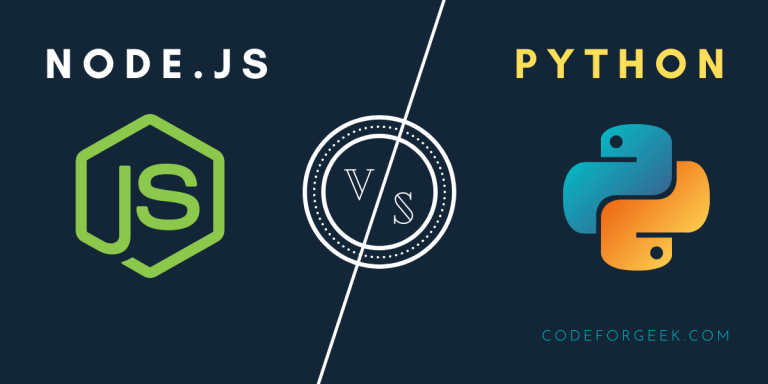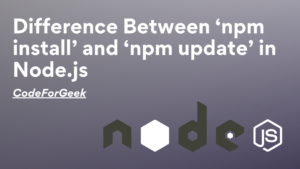The battle of Node.js vs. Python as backend technologies has persistence for decades. Python is a much-established technology with a vast community. While Node.js is quite nascent yet powerful. Nevertheless, both are popular backend technologies and are backed by vast communities.
However, there aren’t really any better or worse programming languages. All programming languages have their own boons and banes. Moreover, it also depends on the developer’s preferences.
In this comparison guide, I will conduct a comprehensive study on advantages, disadvantages, technological similarities, and most importantly; the one you should choose for your application as well as development needs.
Let’s see who wins!
Node.js vs. Python: Synopsis
Both Python and Node.js are widely used server-side (backend) technologies although both of them were created at different times and for different objectives.
Python was founded in the late 1980s. It was built for server-side programming and could be deployed for mobile and web applications. Being around for almost 30 years now, it has a plethora of libraries, tools, and APIs available.
On the other hand, Node.js, founded in 2009, was introduced as a JavaScript runtime that morphed the use of JavaScript on the server-side. Its event-driven approach makes projects scalable and efficient. Most Node.js developers prefer JS for both backend and frontend development.
Node.js vs. Python: In-depth Comparison
It is not accurate to study comparisons without at least one criterion. Since we need to make a cardinal decision of selecting the best technology for the backend, we will be considering multiple criteria to arrive at a decision.
1) Learning Curve & Syntax
The word ‘syntax’ refers to the statement structure of sets of functions in a programming language. The simpler the syntax, the flatter the learning curve.
Node.js
The learning curve for Node.js isn’t as steep if you are familiar with basic JavaScript. However, if you are new to programming, you will take some time to conceptualize Node’s event-driven approach.
Python
If you are a new programmer and had to choose between Node.js and Python, it is recommended that you go with Python. Python has a simpler and compact syntax making the learning curve flatter! Also, there are no curly braces, unlike Node.js.
However, Python indentation and whitespace are sensitive. Meaning, if you misplace your indentation or a single bracket, your code will break. In such cases, new developers find it difficult to troubleshoot errors.
Although both are easy to learn. It more or less depends on whether you have prior knowledge or not.
Node.js is nice and easy when you know some basic JS. Python is great for newbies but will discipline on the indentations.
Winner: Python
2) Community
Every technology requires a community. A community refers to the users and developers that use the technology. Members in a community help other developers (and non-developers too sometimes) solve issues or contribute to the technology.
Active members keep updating popular libraries, add new features and do a lot more!
Node.js
Many of you who haven’t explored Node.js yet, might be under the impression that Node.js is in its nascency and assume its community to be small. Well, you’d be surprised to learn that Node.js has a vast and globally active community with experienced members!
Python
Naturally, Python is an older programming language that has a larger and active community. Python’s community has members of all experience levels, from juniors to seniors.
Winner: Python
3) Libraries & Tools
Libraries simply help you use a code for something, without having to recreate it all by yourself, from scratch. Libraries and packages are the reason why technologies gain popularity and capabilities.
With a library, you can just add code to your project and modify it as per your requirements.
Node.js
Libraries in Node.js are managed by the Node Package Manager. It has the most comprehensive and well-documented library repository. With more than 1.5 million NPM packages, it is the world’s largest package repository in the world.
Python
Libraries in Python are managed by PIP (Pip Installs Packages). Similar to Node.js, Python libraries are well-documented as well as easier to deploy. However, this is only true for older packages. New packages aren’t well-documented also making them less reliable.
Winner: Node.js
4) Performance & Speed
Node.js
Node.js’ non-blocking architecture makes its execution process simpler and faster. To top it all off, it executes the code outside the web browser.
This way the app on the web browser runs faster and performs better making it more efficient. This also allows the Node.js web app to pull features like TCP sockets, which are otherwise unavailable in browsers.
Moreover, Node.js’ single module caching makes the app faster and responsive.
Python
Python has an innate architecture that forbids multithreading. This slows down processing speed as they can’t run parallelly.
Although Python’s syntaxes are easier to learn and run, it is not as fast to able to run applications that require frequent recalling of data from the server. It is not optimized for speed and performance and hence loses.
Winner: Node.js
5) Suitable Apps
Node.js
Since Node.js is event-driven, it makes a perfect technology for applications that demand concurrent requests, heavy rendering on the frontend, or frequent data shuffling from client to server.
It is best suited for real-time communication services and streaming platforms. However, it is still not the best option for building heavy CPU resource consuming apps
Examples include IoT solutions, dynamic one-page apps, and real-time chatbots and messengers.
Python
Python is suitable for both small and big applications. Moreover, it is also powerful enough to create data science apps, which demand analysis and visualization for voice and face recognition and more. It can also be used for developing 3D modeling software and games!
All in all, it all depends on your needs. Hence, this heading doesn’t take as a win or lose.
Conclusion
Choosing between both these technologies is quite tricky. Node.js and Python are both prominent technologies in their ways. However, what’s best for your application, is what I have guided you with, in this post.
In my case, I love using Node.js and stick with it. What’s your choice after reading through this comparison?
Read More: Top 10 Programming Languages
Noteworthy References
FreeCodeCamps’ Comparative Study on Node.js vs Python
Simform’s Comparative Study on Node.js vs Python





